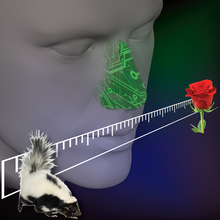
An electronic nose is an electronic sensing device intended to detect odors or flavors. The expression "electronic sensing" refers to the capability of reproducing human senses using sensor arrays and pattern recognition systems.
Since 1982,[2] research has been conducted to develop technologies, commonly referred to as electronic noses, that could detect and recognize odors and flavors. The stages of the recognition process are similar to human olfaction and are performed for identification, comparison, quantification and other applications, including data storage and retrieval. Some such devices are used for industrial purposes.
- ^ Haddad, Rafi; Medhanie, Abebe; Roth, Yehudah; Harel, David; Sobel, Noam (15 April 2010). "Predicting Odor Pleasantness with an Electronic Nose". PLOS Computational Biology. 6 (4): e1000740. Bibcode:2010PLSCB...6E0740H. doi:10.1371/journal.pcbi.1000740. PMC 2855315. PMID 20418961.
- ^ Persaud, Krishna; Dodd, George (1982). "Analysis of discrimination mechanisms in the mammalian olfactory system using a model nose". Nature. 299 (5881): 352–5. Bibcode:1982Natur.299..352P. doi:10.1038/299352a0. PMID 7110356. S2CID 4350740.